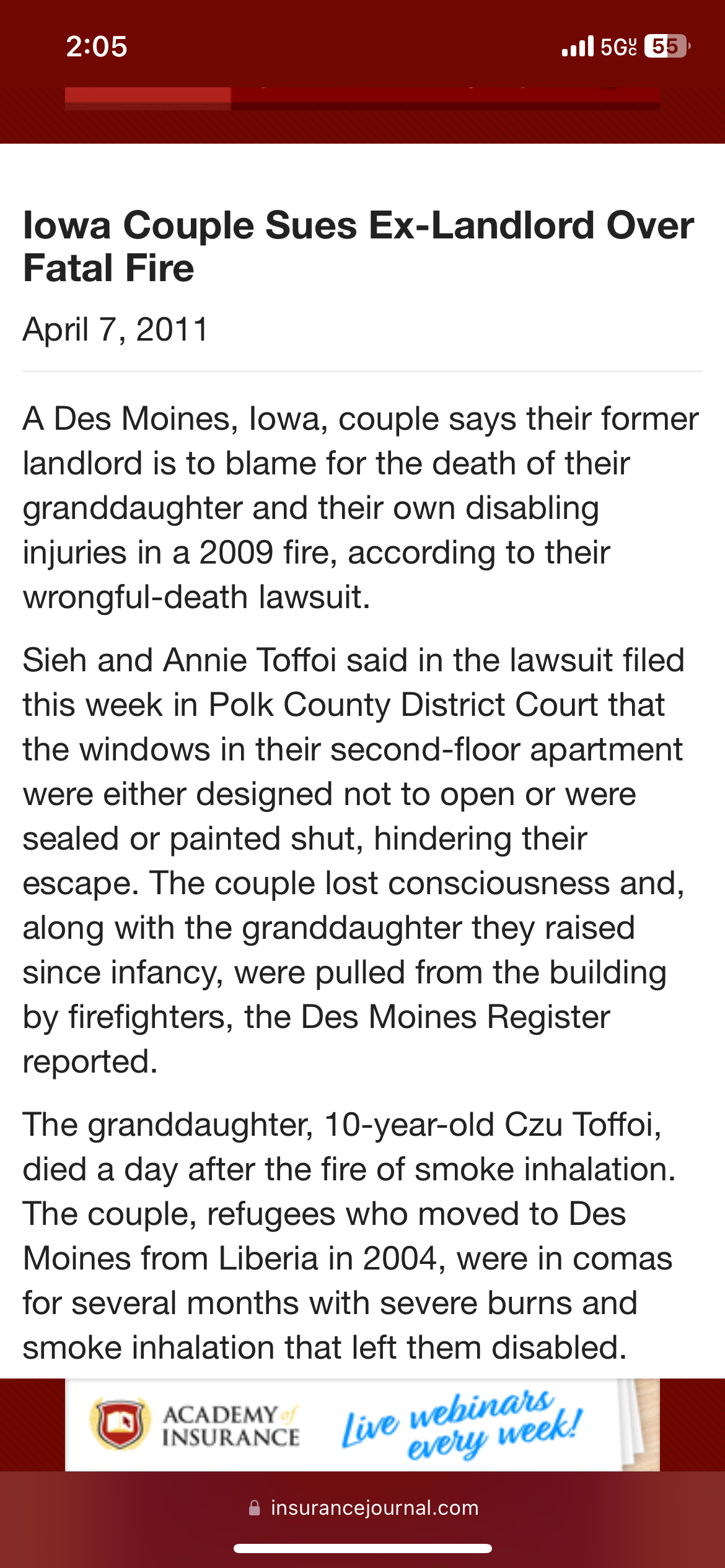- Report: #1470973
Complaint Review: Thomas J. Kent Jr. - New York New York
Thomas J. Kent, Jr. Thomas Jefferson Kent, Jr., Thomas Kent, FDP Capital, Kent Global Thomas J. Kent, Jr. (Thomas Jefferson Kent, Jr.) Imprisoned For Fraud - Justice Served New York New York
FDP Capital, Kent Global were the original scams (take money from companies looking to raise money, lie about being able to raise money and steal the fees from small businesses) which morphed into many other scams.
But in the end, Thomas Jefferson Kent, Jr. (Thomas J. Kent, Jr.) was nabbed by the Feds for fraud and got nailed in the federal penitentiary. When he gets out of prison next year, he will probably be at it again, so buyer beware. If you were scammed by Thomas J. Kent, Jr. and his den of thieves, you may be eligible for restitution, so keep tabs on him and write him in prison if you like, but just know he did not get away with his crimes in the end. Justice Served thanks to Rip-Off Report.
Justice was indeed served. Feds nailed Kent and his friends for Fraud in a New York Federal Courtroom a few years ago. He has been locked up ever since. You may be eligible for restitution if you were scammed by Thomas J. Kent, JR. (Thomas Jefferson Kent, Jr.), FDP Capital, etc.
For more full case information, check New York Federal Court. Also search for: Milroy, Epstein too. The entire crew.
Send him a letter in prison.. Here are his details. Great job by Rip-Off Report to bring this criminal to justice.
THOMAS JEFFERSON KENT (Thomas Jefferson Kent, Jr.) Thomas J. Kent, Jr.
Register Number: 69072-054
Age: 42
Race: Black
Sex: Male
Located at: Lewisburg USP
Release Date: 04/04/2020
Use the addresses below to send correspondence and parcels to inmates. Learn more about sending mail
For inmates at the USP:
INMATE NAME & REGISTER NUMBER
USP Lewisburg
U.S. PENITENTIARY
P.O. BOX 1000
LEWISBURG, PA 17837
1 Updates & Rebuttals
justice-served
New York,New York,
United States
Thomas Jefferson Kent, Sanford Gottesman, Brad Robinson, Beno Matthews Thomas Kent, Thomas J. Kent, Jr., Thomas Jefferson Kent Thomas Jefferson Kent, Thomas Jefferson Kent, Jr., Thomas Kent, Thomas J.
#2Author of original report
Thu, February 14, 2019
Thomas Jefferson Kent, Sanford Gottesman, Brad Robinson, Beno Matthews Thomas Kent, Thomas J. Kent, Jr., Thomas Jefferson Kent Thomas Jefferson Kent, Thomas Jefferson Kent, Jr., Thomas Kent, Thomas J. Kent Sentenced to 78 Months for Financial Fraud - All Case and Conviction Details Enclosed New York New York
Body:
Beginning in 2007, Thomas Jefferson Kent (aka Thomas J. Kent, Jr., Thomas Jefferson Kent, Jr. Thomas Kent) began carrying out a massive fraudulent scheme. Thomas Kent Jr., Thomas Kent, Thomas J. Kent, Jr., Thomas Jefferson Kent, Jr., Thomas Jefferson Kent tried to also sue or claim that he was suing rip-off report for disclosing his fraudulent scheme. He was nabbed by the Feds, him and his crew and all were sentenenced ranging from 36 to 78 months in a Federal Penitentiary with Kent getting the longest sentenced of them all. Thomas Kent, Thomas Jefferson Kent, Jr. tried to appeal but his case was shot down (see below) and he continues to rot in prison until April 2020 for his crimes that hurt so many. If you were damaged by Thomas Jefferson Kent and his crew you may be eligible for restitution. Here is a summary of what he got:
Thomas Jefferson Kent engaged in wire fraud conspiracy case against Kent, Sanford Gottesman, Brad Robinson, and Beno Matthews,who were each convicted in connection with their participation in an “advance fee” scheme—a scheme in which supposed lending companies operated by the defendants falsely promised loans to small businesses and collected fees for fraudulent expenses, while never issuing any loans. Following their arrests and indictment in February 2014, Kent, Robinson, and Matthews entered guilty pleas, 78 months' imprisonment, which was imposed after he pleaded guilty on February 19, 2014, to conspiring to commit wire fraud in violation of 18 U.S.C. § 1349 and ordered to pay $950,000 in restitution.
I. Factual Background 3
The scheme began in 2007, when Kent formed FDP Capital, LLC, to pose as a private investment banking firm willing to provide funding for small businesses. Through FDP Capital, Kent would contact small businesses seeking funding and represent that FDP Capital could provide them with loans. After collecting so-called advance fees from these businesses for various expenses, however, FDP Capital never issued any loans.
Kent recruited Robinson to work for FDP Capital as a broker. Robinson would find and contact prospective customers, solicit and review a “quick information form” submitted from interested businesses, and in turn send those businesses a “letter of intent” setting forth FDP Capital's intent to extend a loan. The letter of intent explained that, before wiring the funds for the loan, FDP Capital would need to conduct certain due diligence. In order to do so, FDP Capital asked the businesses to pay an advance fee to cover expenses, often including the cost of a “site visit” to meet the principals, review the loan proposal, and discuss repayment expectations. Kent and Robinson would conduct those visits themselves.
Through FDP Capital, Kent and Robinson obtained more than $325,000 in advance fees from more than 60 businesses. None of the businesses, however, ever received a loan. After securing the advance fee, FDP Capital would end all contact with the defrauded business, which would find itself unable to reach FDP Capital to inquire about its loan. As a result, many so-called customers filed online complaints about FDP Capital and Kent.
Following the posting of Internet complaints, Kent started a new company, Phoenix Global Holdings, Inc., to perform the same scheme as FDP Capital. He began using aliases—all variations of his name such as Tom Kent, Jeff Kent, and Thomas Jefferson—when communicating with prospective customers. Although Kent still conducted site visits and interacted with customers himself, he no longer did so without using an alias. He also no longer signed any customer documents.
In or around the summer of 2009, Robinson stopped working for Kent for a time, and Kent met and recruited Gottesman to assist in the fraudulent scheme. They agreed to go into business together in September 2009. Gottesman took on the role of conducting the site visits. Kent then enlisted Robinson once more and tasked him with maintaining the mass marketing e-mail server and signing letters of intent. Robinson would also keep Gottesman apprised of the status of client contacts for those businesses Gottesman had visited or was to visit.
During this time the scheme grew, with the co-conspirators sometimes demanding not only advance fees, but also additional fees for fictitious bonds to secure the purported loans. Kent, under new aliases such as “Dan Green” or “Mike Ryan,” spoke with businesses about acquiring those additional payments to secure “investments” from one of the Wilshire entities.
In June 2010, Kent and Gottesman had a falling out. The two men nevertheless continued the same scheme, individually, at Wilshire Financial, Inc., Wilshire Capital, Inc., and subsequently at other entities. Kent recruited Matthews, who had previously helped with technology services, and continued substantially the same scheme through three new companies: Vouyer Capital LLC, Midwest Global Partners, Inc., and Northeast, Inc.
II. Plea and Sentencing Proceedings
Kent pleaded guilty on February 19, 2014, pursuant to a plea agreement that calculated a Guidelines total offense level of 22.4 Based on a criminal history category of I, Kent's stipulated Guidelines range was 41 to 51 months' incarceration. The United States Probation Office subsequently prepared a PSR that arrived at the same Guidelines range. On July 15 and 18, 2014, Kent and the Government filed submissions with the district court in anticipation of sentencing. Kent requested a downward deviation from the Guidelines range, asking that the court impose a 36–month prison sentence. The Government requested that the court impose an incarceration period within the Guidelines range of 41 to 51 months.
Following arguments for mitigation, the district court imposed its sentence on Kent. The district court explained the reasons for imposing the sentence at length, emphasizing the seriousness of Kent's actions. Ultimately, the district court stated that its sentence related to “the number of victims, the prolonged conduct, the severe impact on the victims, the need to incapacitate, the devices and artifices ․ used to escape detection, [the] knowledge as to what [Kent was] doing was wrong, [Kent's] lack of sympathy for the victims, [and] the harm that [was] done all across the country.” K.A. 160. The district court sentenced Kent to 78 months' imprisonment (at the top of the Guidelines range), three years of supervised release, and a mandatory $100 special assessment. It also ordered Kent to pay $953,232.81 in restitution and to forfeit $950,000.
Here is the prison cell where Kent currently lives:
Send him a letter in prison.. Here are his details. Great job by Rip-Off Report to bring this criminal to justice.
THOMAS JEFFERSON KENT Register Number: 69072-054 Age: 42 Race: Black Sex: Male Located at: Lewisburg USP Release Date: 04/04/2020
Use the addresses below to send correspondence and parcels to inmates. Learn more about sending mail
For inmates at the USP: INMATE NAME & REGISTER NUMBER
USP Lewisburg
U.S. PENITENTIARY
P.O. BOX 1000
LEWISBURG, PA 17837
United States Court of Appeals, Second Circuit.
UNITED STATES OF AMERICA, Appellee, v. THOMAS JEFFERSON KENT, also known as Sealed Defendant 1, also known as Daryl Walker, Defendant-Appellant, SANFORD GOTTESMAN, also known as Sealed Defendant 2, BRAD ROBINSON, also known as Sealed Defendant 3, BENO MATTHEWS, also known as Sealed Defendant 4, Defendants.
16-3461-cr Decided: October 05, 2017
Present: DEBRA ANN LIVINGSTON, GERARD E. LYNCH, Circuit Judges, JED S. RAKOFF, District Judge.* For Defendant-Appellant: Yuancheng Lee, Of Counsel, Federal Defenders of New York, Inc., New York, NY. For Appellee: Paul M. Monteleoni, Karl Metzner, Assistant United States Attorneys, for Joon H. Kim, Acting United States Attorney for the Southern District of New York, New York, NY.
UPON DUE CONSIDERATION, IT IS HEREBY ORDERED, ADJUDGED, AND DECREED that the judgment of the district court is AFFIRMED.
Defendant-Appellant Thomas Jefferson Kent pleaded guilty to one count of conspiring to commit wire fraud in violation of 18 U.S.C. § 3571. On July 25, 2014, the district court, applying a § 3B1.1(a) enhancement pursuant to the United States Sentencing Guidelines (“Guidelines”), sentenced Kent to 78 months' imprisonment. This initial sentence was at the top of the Guidelines range calculated by the district court. But the district court explained during the sentencing proceeding that the Guidelines range is “advisory only,” and that the “ultimate sentence is determined by the various factors under [18 U.S.C. §] 3553(a).” J.A. 70. We vacated Kent's initial sentence and remanded for resentencing because the district court did not make the required findings for applying the § 3B1.1(a) enhancement. United States v. Kent, 821 F.3d 362, 371 (2d Cir. 2016). On September 30, 2016, the district court conducted a resentencing hearing and imposed the same aggregate 78-month sentence, but this time without applying the § 3B1.1(a) enhancement. As a result, the same 78-month sentence became an above-Guidelines sentence upon resentencing. Kent appeals from that September 30, 2016 resentencing and contends that the district court's decision to impose such a sentence was vindictive and substantively unreasonable. We assume the parties' familiarity with the underlying facts, the procedural history of the case, and the issues on appeal.
* * *
First, relying on North Carolina v. Pearce, 395 U.S. 711 (1969), Kent argues that the sentence he received on remand was improper because it was imposed by the district court in retaliation for his successful appeal. Pearce held that due process precludes a judge from increasing a defendant's sentence on remand out of “vindictiveness against a defendant for having successfully attacked his first conviction,” and that where a judge imposes “a more severe sentence” after appeal based only on factors present prior to the first sentence, vindictiveness may be presumed. Id. at 725–26; see also United States v. Weingarten, 713 F.3d 704, 713 (2d Cir. 2013) (quoting United States v. Goodwin, 457 U.S. 368, 374 (1982)).
A presumption of vindictiveness would not be appropriate in this case. We note at the outset that Pearce is not directly applicable here because Kent received the same sentence on remand that he had received initially, not a higher one. Kent argues that his sentence nevertheless should be treated as a “more severe” sentence because his case resembles one in which a court increases the sentence on remaining counts after vacatur of a count of conviction. See Weingarten, 713 F.3d at 710–11. Although his single count of conviction was not vacated, Kent contends that his vacated Guidelines enhancement is “functionally equivalent” to a vacated count of conviction. Def.-Appellant Br. 22. But a Guidelines adjustment does not affect “the extent of the harm legally attributable to the defendant” in the same way a vacated count of conviction does. Weingarten, 713 F.3d at 715. Here, resentencing entailed a new Guidelines analysis, but one clearly related to and not independent of the first. In such circumstances, Kent's case is more analogous to those cases involving the vacatur of related counts. And “[w]here one or more of several related counts have been vacated, and the district court on resentencing has increased the sentence on the remaining, related counts to maintain the same aggregate sentence as before, no presumption of vindictiveness applies.” Id. at 714.
Nor is this a case presenting any prospect of actual vindictiveness upon resentencing. Id. at 715 (rejecting actual vindictiveness in part because the “district court's conclusion that its initial aggregate sentence was still appropriate is understandable”); United States v. Hornick, 963 F.2d 546, 547 (2d Cir. 1992) (upholding resentencing because “[t]he original sentence was thus a reflection of the district court's assessment of the aggregate gravity of Hornick's crimes, not a sum arrived at through discrete consideration of distinct crimes”). Here, as in Hornick, “[t]he propriety of the resentence was implicit in our prior opinion.” 963 F.2d at 547. We noted in our prior opinion the possibility that the district court, after taking account of the procedural error we identified, might “impose[ ] the same sentence in any event,” but determined that because we could not know whether the district court would do so, remand for resentencing was proper. Kent, 821 F.3d at 371. We have previously upheld new sentences imposing the same aggregate sentence upon resentencing in similar circumstances. See, e.g., Weingarten, 713 F.3d at 711–12 (upholding new sentence that imposed the same aggregate sentence after vacating a related count of conviction); United States v. Chaklader, 232 F.3d 343, 346–47 (2d Cir. 2000) (upholding new sentence that imposed the same aggregate sentence by reapportioning original sentence between the underlying offenses and the sentencing enhancement after a mistake in calculating the initial sentence); Hornick, 963 F.2d at 546–47 (upholding new sentence that imposed the same aggregate sentence after remanding because a sentencing enhancement was improperly applied).
Finally, we do not agree with Kent that his sentence was substantively unreasonable. The standard of review for substantive reasonableness is a “deferential abuse-of-discretion standard,” United States v. Cavera, 550 F.3d 180, 194 (2d Cir. 2008) (en banc), and we set aside a district court's sentencing judgment only in the “proverbial ‘rare case’ ” of a sentence that is “shockingly high” or “otherwise unsupportable as a matter of law,” United States v. Rigas, 583 F.3d 108, 122 (2d Cir. 2009). The district court's imposition of a 78-month sentence (15 months greater than the top end of the calculated Guidelines range) cannot in the circumstances here be deemed either shocking or even unusual, especially because a reviewing court “may not apply a presumption of unreasonableness” simply because a sentence is outside the Guidelines range. United States v. Pope, 554 F.3d 240, 246 (2d Cir. 2009) (quoting Gall v. United States, 552 U.S. 38, 51 (2007)). After all, “sentencing discretion is like an elevator in that it must run in both directions ․ [so] district courts have the power to impose sentences both above and below the Guidelines range.” Cavera, 550 F.3d at 194.
Furthermore, “a district court's decision to vary from the Guidelines ‘may attract the greatest respect when the sentencing judge finds a particular case outside the “heartland” to which the Commission intends individual Guidelines to apply.’ ” Id. at 193 (citation omitted). Here, the district court made the explicit finding that “[t]he Court does not believe that this particular offense was within the heartland of the guidelines.” J.A. 188. The district court also explained in depth its application of the 18 U.S.C. § 3553(a) factors, and why it viewed this crime as “outside the ‘heartland.’ ” J.A. 186–90. “[W]e must defer heavily to the expertise of district judges ․ [and so w]e do not consider what weight we would ourselves have given a particular factor.” Cavera, 550 F.3d at 191.
Based on the record before us, there is no evidence of presumed or actual vindictiveness, and the district court's decision to impose the same 78-month sentence at Kent's resentencing was substantively reasonable. We have considered Kent's remaining arguments and find them to be without merit. Accordingly, we AFFIRM the judgment of the District Court.
FOR THE COURT:
Catherine O'Hagan Wolfe, Clerk



























